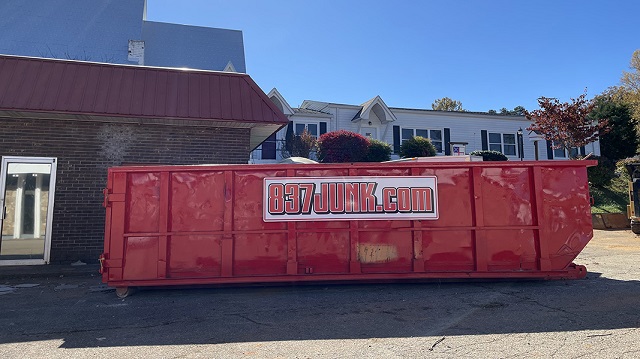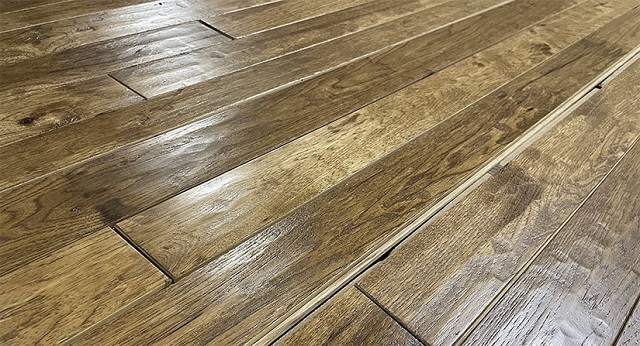How to Throw Away Hardwood Floors the Right Way
Wood Disposal Tips

Understanding Why Hardwood Floor Disposal Matters
Disposing of hardwood floors might seem like a straightforward task, but doing it improperly can lead to serious consequences. Violating city codes can lead to fines so it's important to know the right way to manage your flooring waste.
Signs It's Time to Remove Your Wood Floors
Not sure if your hardwood floors need to go? Here are a few signs it’s time for your home to say goodbye:
Water Damage and Mold
Water exposure over time can seep into the seams and boards, leading to warping and the development of mold underneath. Once mold sets in, it's hard to save the flooring without risking your health. If you suspect this is the case, try to remove a plank to see if any black mold collection is growing on your subfloor.
Extensive Wear and Tear
Scratches, splinters, deep gouges, and loose boards are all signs your hardwood has lived its life. If the floors squeak excessively, feel uneven, or look irreparably damaged, replacing them is likely the best option.
Preparing for Removal of Wood Flooring
Before swinging that crowbar, take some precautionary steps to ensure a clean and safe removal.
Gather Proper Tools and Safety Gear
You'll need gloves, eye protection, a pry bar, hammer, dust mask, and possibly a circular saw or floor scraper. Having the right tools makes the job smoother and safer.
Clear the Room and Prep the Surface
Remove furniture, rugs, and baseboards. Cover vents and seal off other areas to prevent dust from spreading throughout your home.
Step-by-Step: How to Rip Out Wooden Floors Safely
Now let’s get into the actual removal process. Here's how to do it right:
Start at the Right Place
Pick a loose board near the edge or a damaged area. This makes it easier to get your tools under the boards and start the tear-out process.
Use the Right Technique
Insert a pry bar under the boards and gently lift. If the wood is nailed down, use a mallet for extra leverage. If glued, slice through the adhesive with a utility knife or scraper.
Sort it out
Separate usable planks from damaged ones. Good pieces can be saved for other projects or other rooms that share the same wood floors for future repairs.

Where and How to Dispose of Wood Scraps
This is the part where many homeowners make mistakes. Simply tossing your boards into an apartment dumpster or leaving them on the curb won’t cut it. Ideally renting 10 yard dumpsters for a floor disposal job is best.
Avoid Dumpsters Without Permits
In many municipalities, tossing large construction debris and wood scraps like hardwood flooring in regular dumpsters can lead to expensive fines. Permits are often required, most disposal guides don't warn you of this.
Hire a Professional Waste Management Company
The safest, easiest way to throw away hardwood floors is to call a professional waste management service like 837 JUNK. They handle the rental logistics, transport, and deal with proper disposal according to local regulations. This is especially important if you’ve just ripped up large sections of flooring and plan for a quick clean-up 10 yard dumpster solution.
Recycling vs. Throwing Away
Many hardwoods can be recycled or reused after you rip them out of your home. Some waste removal centers accept wood waste for mulch or alternative uses. A dumpster rental is much easier to plan around and their services always work around your schedule at home.
Alternative Uses for Old Flooring
If your boards are still in decent shape, don’t trash them. Post them on Facebook marketplace so someone can transform them or send them to recycling centers!
DIY Furniture or Home Decor
Old planks make great coffee tables, wall art, headboards, and bookshelves. They add rustic charm and keep materials out of landfills.
Donating Usable Flooring
Check with local nonprofits or Habitat for Humanity. Some centers accept gently used flooring to help build homes or fund projects. It doesn't matter if you're trying to send them vinyl flooring or tiles as well. Most places won't accept carpet.
Choosing New Flooring After Removal
Once your old floor is out, it’s time to think about what comes next.
Why Shop at Budget-Friendly Suppliers
Flooring can be expensive—but it doesn’t have to be. ReallyCheapFloors.com offers excellent quality flooring at unbeatable prices, perfect for your next renovation. Whether you're going for engineered hardwood, luxury vinyl, or solid wood, their selection covers all bases without breaking the bank.
Common Mistakes to Avoid When Disposing Hardwood Floors
- Dumping wood in unauthorized dumpsters
- Forgetting to check local disposal laws
- Not separating salvageable wood
- Ignoring protective gear during removal
- Overloading your vehicle with debris
FAQs About Disposing of Wooden Floors
Q1: Can I burn old hardwood floors? No. Most hardwood floors have finishes that release toxic fumes when burned.
Q2: Is it okay to leave flooring on the curb for trash pickup? Typically not. Call your city or a junk removal service for large debris.
Q3: Can I reuse my old hardwood floors in another room? Yes, if they are in good condition and can be refinished.
Q4: How much does hardwood floor removal cost? It varies by size and condition but expect to pay between $1-$4 per square foot for removal, not including disposal.
Q5: Are hardwood floors recyclable? Yes, especially if they're solid wood. Engineered wood is more difficult to recycle.
Q6: What’s the best place to buy replacement floors? We recommend shopping online flooring retailers for the best deals on flooring.
Final Thoughts on Responsible Wooden Disposal
Disposing of hardwood floors doesn’t have to be a headache or a safety concern. With a bit of planning, the right tools, and help from a professional waste management company, you can safely and efficiently clear out your home of old flooring.
Hardwood floors are made of dense material and are often treated with chemicals. Tossing them into regular trash bins or illegal dumping can lead to fines or cause long-term environmental harm. Instead, careful planning and proper disposal ensure both safety and compliance.
Related posts:
 In the Volgograd Region Administration, a concession agreement was signed on public utilities, recycling, disposal (storage) of solid household waste. According…
In the Volgograd Region Administration, a concession agreement was signed on public utilities, recycling, disposal (storage) of solid household waste. According… The building is already over, and a bunch of building debris and waste remains lying, rather than seriously ruining the type of capital. As a result, today the required…
The building is already over, and a bunch of building debris and waste remains lying, rather than seriously ruining the type of capital. As a result, today the required… I ve done a lot of franchise monitors, but I ve got the usual bids, a cafe or a store that s already starting to compete with me, I thought I was bored, telling…
I ve done a lot of franchise monitors, but I ve got the usual bids, a cafe or a store that s already starting to compete with me, I thought I was bored, telling… Between 80 per cent and 85 per cent of the debris is exported for burial to special polygons. Every year, the number of solid domestic waste in Russia is increasing…
Between 80 per cent and 85 per cent of the debris is exported for burial to special polygons. Every year, the number of solid domestic waste in Russia is increasing… Is discipline important in investing? Without any doubt it is true! A disciplined investor will never buy securities without serious analysis or pay attention to…
Is discipline important in investing? Without any doubt it is true! A disciplined investor will never buy securities without serious analysis or pay attention to… Structural debris: brick, brisket, concrete, stoves obtained during the dismantling of construction sites are transformed into a secondary building block on GOST…
Structural debris: brick, brisket, concrete, stoves obtained during the dismantling of construction sites are transformed into a secondary building block on GOST… Professional presentation demands more than just content - it requires the right display platform. The Black Easel stands out as a sophisticated solution for artists…
Professional presentation demands more than just content - it requires the right display platform. The Black Easel stands out as a sophisticated solution for artists… The Investor will deposit 200 million roubles in the Siberian garbage processing plant, the Head of the region said that quality recycling of debris should be required…
The Investor will deposit 200 million roubles in the Siberian garbage processing plant, the Head of the region said that quality recycling of debris should be required… The Territorial Waste Management Scheme was held by the Parliamentary Hearings at Medoldum Parliamentary hearings of the Regional Waste Management Scheme were held…
The Territorial Waste Management Scheme was held by the Parliamentary Hearings at Medoldum Parliamentary hearings of the Regional Waste Management Scheme were held… Environmentally sound behaviour is very often consistent with the principles of rationality, servitude, prudential treatment of purchases, by their time, to environmental…
Environmentally sound behaviour is very often consistent with the principles of rationality, servitude, prudential treatment of purchases, by their time, to environmental…